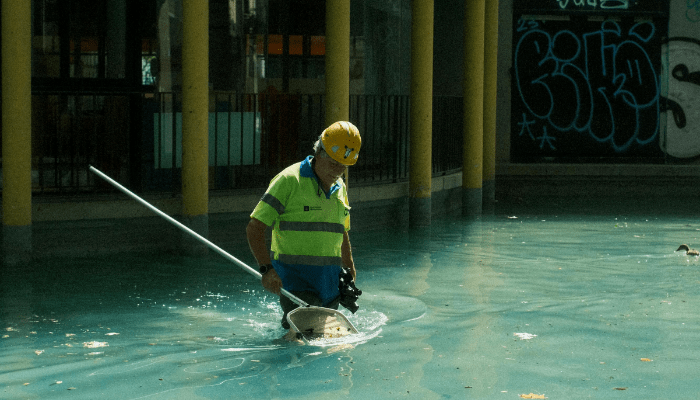Key Takeaways
A pool can turn green in just two days if cleaning is neglected, so consistency is crucial.
Basic tools like a skimmer net, vacuum, brush, test kit, and sanitizer are enough to keep most pools clear.
Daily skimming, weekly vacuuming and brushing, and monthly filter cleaning and shocking form the core routine.
Balanced water chemistry (pH, chlorine, alkalinity) prevents algae, cloudy water, and irritation.
Common issues like algae or cloudy water are usually solved with proper filtration, brushing, and timely shocking.
Avoid mistakes like ignoring the filter, skipping tests, or running the pump too little.
Tools such as robotic cleaners, digital testers, and automatic skimmers save time and effort.
Adjust maintenance seasonally with extra testing in summer, leaf management in fall, and full winterizing before freezes.
Hiring a pro is smart for major algae outbreaks, equipment issues, or when you’re short on time.
Cleaning isn’t about perfection. It’s about habits that let you enjoy your pool instead of fighting it.
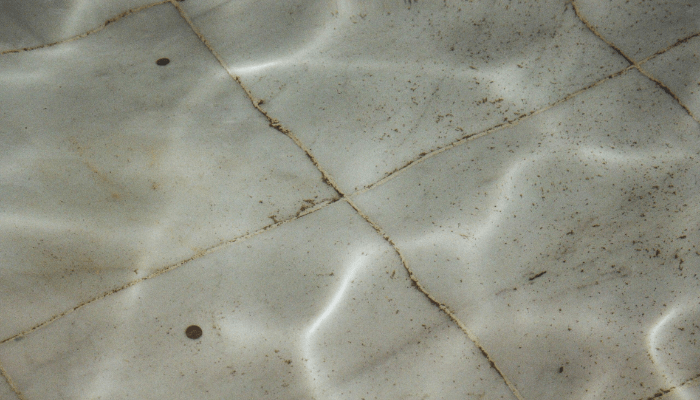
A neglected swimming pool can turn green in as little as two days. Two. Days. That’s how important cleaning a swimming pool is.
Algae don’t care how expensive your pool was. Or how nice the weather is. Or whether you’ve got guests arriving Saturday. If you skip regular cleaning, that water’s going to turn into a murky science experiment faster than you can Google “what is pool shock.”
Here’s the truth: cleaning a swimming pool doesn’t have to be complicated, but it does have to be consistent.
Most people make one of two mistakes. They either overcomplicate things and panic-buy twenty different products. Or they wait until the water looks suspicious and start scrubbing like they’re prepping for a health inspection.
Neither works.
This guide is for the rest of us. The pool owners who want clear water, fewer headaches, and no expensive surprises. You’ll learn what to clean, when to clean it, and how to keep your water safe without spending your weekends chained to a vacuum pole.
No fluff. No 14-step routines that only work for Olympic pools. Just real, smart strategies for a clean swimming pool, whether you’re maintaining it solo or overseeing it for clients.
Let’s dive in. Figuratively for now.

What You’ll Need Before You Start
Let’s not overcomplicate it. You don’t need a PhD or a closet full of mysterious chemicals. Just the basics.
- A pool skimmer net
- Telescopic pole (ideally extendable)
- Pool vacuum (manual, automatic, or robotic, pick your time budget)
- Pool brush
- Water test kit (liquid or digital, not just strips)
- Sanitizer (chlorine, bromine, or salt system)
- Filter cleaner
One more thing: a habit. Tools are great, but consistency is better.
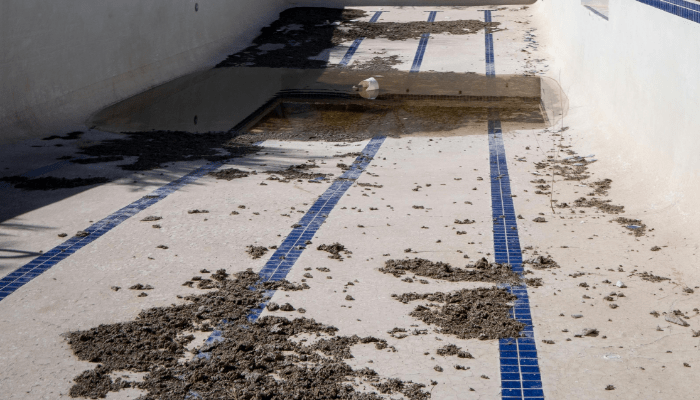
Daily, Weekly, and Monthly Pool Cleaning Tasks
You wouldn’t floss once a month and expect perfect teeth. Pools are the same. Here’s what your schedule should look like:
Daily Tasks
- Skim leaves and surface debris. It takes 2 minutes and keeps your filter happy.
- Check the water level, mid-skimmer box is ideal.
- Quick pH test? Yes. Even test strips are fine for daily check-ins.
Weekly Tasks
- Vacuum the pool. Manual or robotic. Just do it.
- Brush the walls and steps. Algae loves to hide in corners.
- Empty the skimmer and pump baskets.
- Test full water chemistry: pH, chlorine, alkalinity. Adjust as needed.
Monthly Tasks
- Deep clean your filter. Backwash or hose it out depending on type.
- Inspect pool equipment. Look for leaks, wear, odd noises.
- Shock the pool, especially after parties, rainstorms, or heavy use.
It’s all about rhythm. Skip the rhythm, and the green stuff wins.

Step-by-Step Guide on Cleaning a Swimming Pool
If you’ve got 30 minutes a week, you can have a crystal-clear pool. Here’s how.
Step 1: Remove Debris
Grab your skimmer net and sweep the surface. Don’t just chase the big stuff, scoop out pollen, bugs, and that one leaf that refuses to die with dignity.
If it’s windy or surrounded by trees, do this daily. It’s your pool’s first defense.
Step 2: Brush the Walls and Floor
Use a stiff-bristled brush and go over the walls, floor, and steps. Think of it like brushing your hair: you’re not just making it look nice, you’re loosening the stuff that’s stuck.
Focus on shady spots, ladders, and corners. Algae loves those areas. You shouldn’t.
Step 3: Vacuum the Pool
If you’re using a manual vacuum, plug it into the skimmer, move slowly, and overlap your strokes. Like mowing a lawn underwater.
If you’ve got a robotic cleaner, lucky you, drop it in, hit start, and watch it hustle.
Cloudy water after vacuuming? Your filter might need attention. Or you vacuumed too fast and stirred things up.
Step 4: Clean the Filter
This is your pool’s liver. Don’t ignore it.
- Sand filter? Backwash until water runs clear.
- Cartridge? Hose it out thoroughly.
- DE filter? Backwash and top up DE powder as needed.
Dirty filters cause cloudy water, poor circulation, and angry pool owners. Keep it clean.
Step 5: Balance the Water Chemistry
Test your water. Not once a month, weekly. Use a liquid or digital kit for accuracy.
Target levels:
- pH: 7.2-7.6
- Chlorine: 1-3 ppm
- Alkalinity: 80-120 ppm
- Calcium: 200-400 ppm
- Cyanuric acid (if used): 30-50 ppm
If numbers are off, adjust. Carefully. Don’t play chemical roulette.
Step 6: Shock the Pool (Optional, But Smart)
If your pool smells like a bleach factory or your water looks hazy, it’s time to shock.
Use calcium hypochlorite or a non-chlorine oxidizer. Do it at night. Run the pump. Don’t swim until chlorine normalizes.
Shocking once a month is a good rule unless your pool gets hammered by rain, people, or wild animals.
Dealing With Common Pool Cleaning Issues
Even if you’re doing everything “right,” weird stuff can happen. Here’s how to fix it fast.
Cloudy Water
Causes: poor filtration, imbalanced chemistry, too many swimmers, too much rain.
Fix: check filter, vacuum debris, shock the pool, adjust pH.
Algae Growth
Green? You’re early. Black? You’ve got work to do. Yellow? You’ve angered the pool gods.
Fix: shock hard, brush like crazy, run the pump 24/7 for 24-48 hours. Repeat if needed.
Chlorine Smell or Irritation
Ironically, that strong chlorine smell means you don’t have enough free chlorine.
You’ve got chloramines, spent chlorine particles that need to be oxidized.
Fix: shock the pool. Then test and rebalance.
Pool Cleaning Mistakes to Avoid
Here’s how not to become a cautionary tale in a pool store:
- Ignoring your filter. It does the heavy lifting, treat it right.
- Not brushing regularly. Vacuuming isn’t enough. Algae sticks.
- Skipping water tests. Don’t guess. Test. Always.
- Over-shocking. It’s not “more is better.” Follow the dosage.
- Running the pump too little. 6-8 hours a day, minimum. 10-12 in hot weather or high use.
A clean pool starts with smart habits, not heroics.
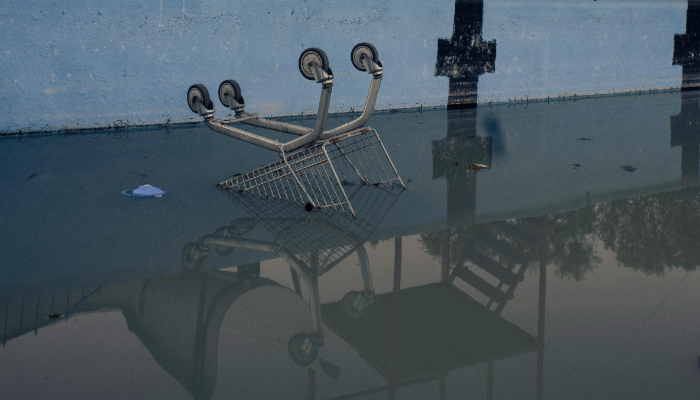
Tools That Make Pool Cleaning Easier
Work smarter, not harder. These tools are worth every penny:
- Robotic Pool Cleaners: They vacuum, climb walls, and some even scrub your tile line.
- Digital Testers: Faster and more accurate than strips. Some even sync with your phone.
- Automatic Skimmers: These float on the surface and eat leaves before you even see them.
- Pool Monitoring Apps: Track pH, chlorine, and even remind you to shock.
Technology won’t clean the pool for you, but it’ll make sure you never forget to.
When to Hire a Pro
Sometimes, calling a professional isn’t weakness. It’s wisdom.
- Algae outbreaks that won’t die
- Equipment malfunctions or leaks
- Heavy debris after storms
- Vacation season or no time to DIY
Expect to pay $75-150 per visit, depending on service and pool size. It’s still cheaper than draining and refilling the entire thing.

Cleaning a Swimming Pool Seasonally
Each season throws new pool problems your way. Adjust your routine, and stay ahead.
Spring Opening Checklist
- Remove the cover
- Reconnect equipment
- Test and rebalance water
- Clean everything, start fresh
Summer Routine Adjustments
- Run pump longer
- Test water more often (2-3 times/week)
- Clean filters every 2-3 weeks
More swimmers = more problems if you’re not on top of it.
Fall Leaf Management
- Skim daily
- Use a leaf net or cover
- Clean baskets frequently
- Watch pH, organic debris lowers it fast
Winterizing Your Pool
- Lower the water level
- Add winter chemicals
- Cover securely
- Blow out lines if you’re in a freeze zone
Winter prep = spring sanity.
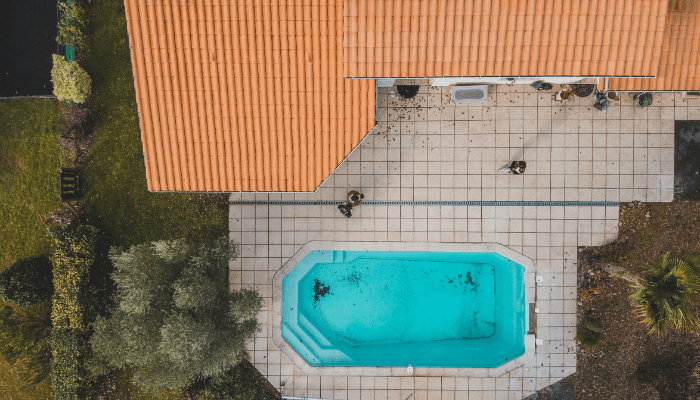
Conclusion
So here’s the bottom line: cleaning a swimming pool is 80% routine, 20% knowing what the heck you’re doing.
If you stay on top of skimming, vacuuming, and water balance, you’ll spend way less time dealing with cloudy water, green gunk, or panic Googling pool chemistry at 11pm.
Get a system. Stick to it. And don’t cheap out on your test kit, that little thing is your early warning system, not a suggestion box.
If something goes wrong, now you know how to fix it. If things are working great, even better, you’ve just added another stress-free weekend to your calendar.
Remember: the goal isn’t just to have a pool. It’s to enjoy it. Regular cleaning is what makes that possible.
And if you ever feel like skipping a week? Just think about swimming through green Jell-O. That should do the trick.
Check out our blog on the essentials for cleaning a swimming pool.
Less stress, more swim.
Oásis Biosistema helps you design low-maintenance, high-enjoyment pools with smarter systems and better tools.
FAQ
What is the best way to clean a swimming pool?
The best way to clean a swimming pool is by skimming debris daily, brushing walls weekly, vacuuming regularly, and keeping the filter system running efficiently. Test water chemistry often and balance pH, chlorine, and alkalinity. A consistent cleaning schedule keeps your pool safe, clear, and ready to enjoy.
How to get a crystal clear pool?
To get a crystal clear pool, ensure proper filtration, maintain balanced water chemistry, and shock the pool weekly. Regularly skim, brush, and vacuum. Keep chlorine levels stable and use a clarifier if needed. Clear water results from clean surfaces, good circulation, and precise chemical management.
How do you maintain a pool for beginners?
Beginner pool maintenance starts with daily skimming, weekly brushing and vacuuming, and testing water 2–3 times per week. Balance pH, chlorine, and alkalinity levels. Keep your filter clean and run the pump daily. Consistency and basic equipment are key to keeping your pool clean, safe, and stress-free.
What are the three C’s of pool cleaning?
The three C’s of pool cleaning are Circulation, Cleaning, and Chemistry. Circulation keeps water moving and filtered, cleaning removes debris and algae, and chemistry ensures water is balanced and safe. Mastering these three elements is essential for a clean, healthy, and crystal-clear swimming pool.

